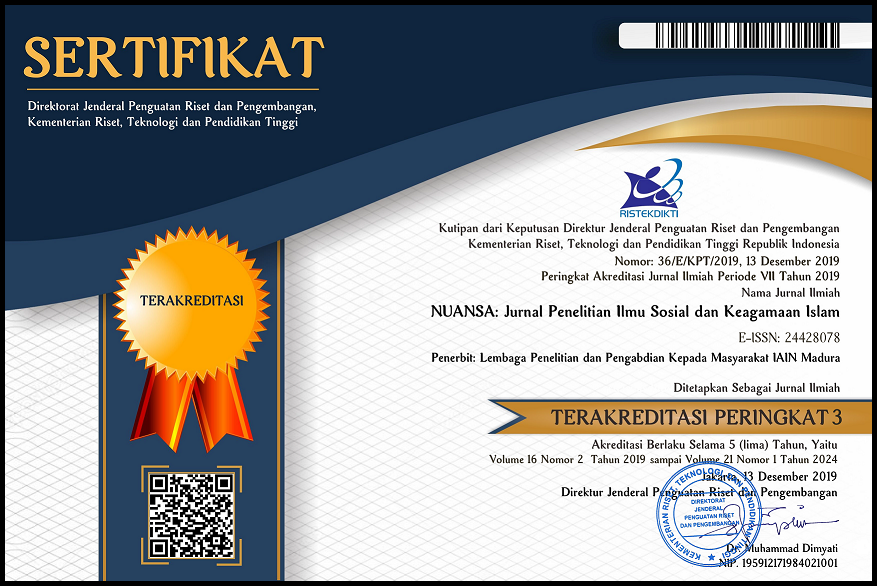Potentials and Challenges of Chinese Foreign Direct Investment in Indonesia
 Abstract views: 1223
,
Abstract views: 1223
,
 PDF downloads: 991
PDF downloads: 991
Abstract
Program ekonomi China Belt and Road Initiatives (BRI) memiliki pengaruh besar pada laju ekonomi dunia, terutama di negara-negara tuan rumah yang berpartisipasi di dalamnya. Indonesia adalah negara yang menjadi bagian dari program ini di kawasan Asia Tenggara, mengalami dampak yang cukup besar dalam hal pembangunan ekonomi dan peningkatan nilai investasi asing, yang ditandai dengan penambahan proyek investasi di berbagai bidang industri. Pertumbuhan investasi asing Cina di Indonesia dapat dilihat dari perkembangan taman industri Cina di beberapa daerah di Indonesia. Artikel ini disusun dengan melakukan tinjauan literatur dan pengumpulan data yang akurat yang bersumber dari Badan Koordinasi Penanaman Modal Indonesia (BKPM) dengan tujuan untuk menganalisis potensi dan tantangan yang muncul dari FDI Tiongkok untuk Indonesia dan sebaliknya. Hasil yang diperoleh dari penelitian ini adalah, terlepas dari potensi pangsa pasar Indonesia karena jumlah penduduk yang besar, kemudahan memperoleh bahan baku untuk produksi dan upah minimum untuk pekerja lokal relatif rendah. Namun, bagi investor Cina, hal ini diikuti oleh tantangan yang juga muncul, seperti harga tanah yang tinggi, infrastruktur Indonesia yang tidak memadai, dan berbagai peraturan investasi di hampir setiap wilayah. Bagi Indonesia, peningkatan FDI Cina mendorong lapangan kerja, memberikan peluang bagi alih teknologi dan pengetahuan. Namun, masalah lain muncul, seperti persaingan untuk pengusaha lokal dan kekhawatiran tentang ketergantungan ekonomi Indonesia pada Cina. Selain itu, untuk mendapatkan pemahaman komprehensif tentang taman Industri Cina dan dampaknya, penelitian masa depan dengan penelitian survei lapangan sangat dianjurkan.
(The China Belt and Road Initiatives (BRI) economic program has an enormous influence on the pace of the world economy, especially in host countries that participate in it. Indonesia is a country that is a part of this program in the Southeast Asian region, experienced a considerable impact in terms of economic development and an increase in the value of a foreign investment, which is marked by the addition of investment projects in various fields of industry. The growth of Chinese foreign investment in Indonesia can be seen by the development of Chinese industrial parks in several regions in Indonesia. This article was prepared by conducting a literature review and accurate data collection sourced from the Indonesia Investment Coordinating Board (IICB) with the objectives to analyze the potentials and challenges that arise from Chinese FDI for Indonesia and vice versa. The results obtained from this study are, despite the potential of the Indonesian market share due to the large population, the ease of obtaining raw materials for production and the minimum wage for local workers is relatively low. However, for Chinese investors, it is followed by challenges that also arise, such as high land prices, inadequate Indonesian infrastructure, and different investment regulations in almost every region. For Indonesia, an increase in Chinese FDI encourages employment, provides opportunities for the transfer of technology and knowledge. However, other issues arise, such as competition for local entrepreneurs and concerns about Indonesia's economic dependence on China.Besides, to get a comprehensive understanding of Chinese Industrial parks and their impact, future research with field survey research is highly recommended).
Downloads
References
Alfaro, Laura, and Jasmina Chauvin. “Foreign Direct Investment, Finance and Economic Development.” Faculty & Research 1 (2020): 231–258.
BPS. “Indonesia Economic Growth.” Jakarta, 2019.
———. Statistical Yearbook of Indonesia 2019. Edited by Sub-directorate of Statistical Compilation and publication. Jakarta: Indonesian Bureau of Statistics, 2019.
Chaudhary, Anjali. “Role of Foreign Direct Investment (FDI) in the Growth of Indian Agricultural Sector: A Post Reform Study.” Global Journal of Finance and Management 8, no. 2 (2016): 119–29. https://www.ripublication.com/gjfm16/gjfmv8n2_02.pdf.
Damuri, Yose Rizal, Vidhyandika Perkasa, Raymond Atje, and Fajar Hirawan. “Perceptions and Readiness of Indonesia towards Belt and Road Initiatives.” Jakarta, 2019.
Domestic and Foreign Direct Investment Realization Indonesia Invetment Coordinating Board. Indonesia Investment Coordinating Board. Jakarta, 2019.
Dunford, Michael, and Weidong Liu. “Chinese Perspectives on the Belt and Road Initiative.” Cambridge Journal of Regions, Economy and Society 12, no. 1 (February 20, 2019): 145–67. https://doi.org/10.1093/cjres/rsy032.
Gill, I. Future Development Reads: China’s Belt and Road Initiative. Washington: Brookings Institution, 2017.
Ha, L. T. “Chinese FDI in Vietnam: Trends, Status and Challenges.” ISEAS Yusof Ishak Institute Journal 34 (2019): 1–10.
Haryono, Imam. “The Development of Manufacturing Industrial Estate in Indonesia.” Tokyo, 2015.
Kentjana, N. R. Opportunities for Foreign Direct Investment in Indonesia Director of Investment Promotion Development. Jakarta: Indonesia Investment Coordinating Board, 2017.
KPMG Indonesia. “ASEAN Business Guide: Indonesia.” Jakarta, 2018.
News Antara. “Indonesia-China Cooperation Agreement in 8 Aspects.” Antaranews.com, 2015. https://www.antaranews.com/berita/487606/indonesia-tiongkok-sepakati-kerja-sama-delapan-bidang.
Octavia, J. “Rebuilding Indonesia’s Industrial Estates.” Indonesia Investment Coordinating Board, 2016, 1–14.
Realization of Foreign and Domestic Capital Investment. Indonesia Investment Coordinating Board. Jakarta, 2019.
Sari, E. W. “Industry Leading Sectors in Sumedang,” 2015. http://erlindasoledad.blogspot.com.
Song, Tao, Weidong Liu, Zhigao Liu, and Yeerken Wuzhati. “Chinese Overseas Industrial Parks in Southeast Asia: An Examination of Policy Mobility from the Perspective of Embeddedness.” Journal of Geographical Sciences 28, no. 9 (September 27, 2018): 1288–1306. https://doi.org/10.1007/s11442-018-1526-5.
Su, Yaqin, and Zhiqiang Liu. “The Impact of Foreign Direct Investment and Human Capital on Economic Growth: Evidence from Chinese Cities.” China Economic Review 37 (February 2016): 97–109. https://doi.org/10.1016/j.chieco.2015.12.007.
Toader, Elena, Bogdan Firtescu, Angela Roman, and Sorin Anton. “Impact of Information and Communication Technology Infrastructure on Economic Growth: An Empirical Assessment for the EU Countries.” Sustainability 10, no. 10 (October 17, 2018): 3750. https://doi.org/10.3390/su10103750.
UNCTAD. ASEAN Investment Report 2017. 50th ed. Jakarta: The ASEAN Secretariat, 2017.
Weissleder, L. “Foreign Direct Investment in the Agricultural Sector in Ethiopia.” ECOFAIR TRADE DIALOGUE. Berlin, 2009.
World Bank. “Indonesia Overview,” 2019. http://www.worldbank.org/en/country/indonesia/ overview.
Yean, T. S. “Chinese Investment in Malaysia : Five Years into the BRI.” ISEAS Yusof Ishak Institute Journal 11 (2018): 1–9.
Zeng, G, H Zhao, and H. Hu. Report on Construction and Development of China’s Overseas Industrial Parks under the “Belt And Road” Initiatives. Beijing: China Social Sciences Press, 2018.
The journal operates an Open Access policy under a Creative Commons Attribution-NonCommercial 4.0 International License (CC-BY-NC) 
Authors who publish with this journal agree to the following terms:
- Authors retain copyright and grant the journal right of first publication with the work simultaneously licensed under a Creative Commons Attribution License that allows others to share the work with an acknowledgement of the work's authorship and initial publication in this journal.
- Authors are able to enter into separate, additional contractual arrangements for the non-exclusive distribution of the journal's published version of the work (e.g., post it to an institutional repository or publish it in a book), with an acknowledgement of its initial publication in this journal.
- Authors are permitted and encouraged to post their work online (e.g., in institutional repositories or on their website) prior to and during the submission process, as it can lead to productive exchanges, as well as earlier and greater citation of published work.





















